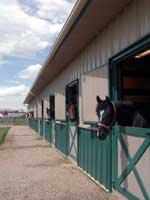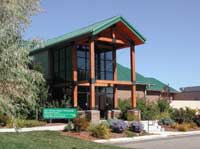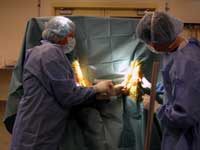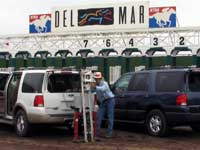Equine Orthopaedics Joins Engineering in Studying Race Track Surfaces
 |
Catastrophic injury to the musculoskeletal structure is one of the major reasons we lose equine athletes such as Barbaro. In many cases, saving the horse is not possible when the injuries are severe or occur in a certain locations. A number of factors have been associated with catastrophic injuries to racehorses, including training methods, genetic predisposition, conformation and pre-existing disease. But the possible correlation between injuries and race track surfaces is generating the most concern in the racing industry.
A three-year collaboration between researchers at Colorado State University and the University of Maine has resulted in a unique method of objectively characterizing properties of a race track and their relationship to forces on a limb. The collaboration involves Dr. Wayne McIlwraith, professor of surgery and Director of the Orthopaedic Research Center at Colorado State, Dr. Michael Peterson, professor of engineering at the University of Maine, and Dr. Raoul Reiser, professor of health and exercise science at Colorado State.
Previous studies of track surfaces have been limited to measuring the vertical impact of the hoof, but it is now recognized that the shear stresses for both the stance phase of the stride and the break-over need to be studied as well. By modeling both the horizontal and vertical components, Peterson is able to accurately reproduce the loading on the leg of the animal and thus the primary force transferred through the forelimb of the galloping horse during the hoof impact on a dirt or synthetic track.
 |
 |
 |
The establishment of maintenance protocols and reduction of variability in the surface are both crucial to improving the safety of race tracks. A multifaceted engineering protocol has been developed for both compositional testing, which includes particle size, clay mineralogy, organic content and moisture content for dirt, as well as wax content, rubber and fiber content, temperature sensitivity and resistance to separation for synthetic tracks. For performance testing at the tracks, Peterson and his research team use a biomechanical hoof to measure shear strength and vertical modulus; a ground-penetrating radar is used to evaluate the integrity of the base layer which underlies the racing surface. These two systems have been used to evaluate both dirt race tracks and synthetic surfaces at more than 15 tracks in the US and Canada.
While synthetic race tracks have decreased the number of catastrophic injuries McIlwraith says that there is still a lot to be learned and current synthetic tracks are not the panacea that some people have hoped for. However, the scientists believe that with further objective monitoring with the system Peterson has developed, and validation of the techniques at CSU's Orthopaedic Research Center, they will be able to greatly improve the welfare of our equine athletes.
For more information on the Orthopaedic Research Center at Colorado State University please visit http://www.equineortho.colostate.edu/